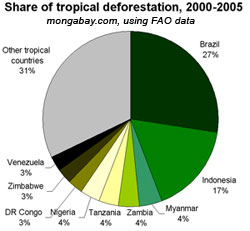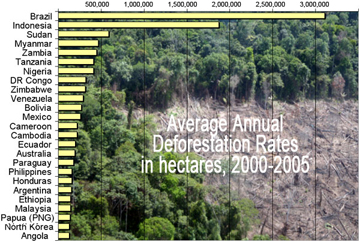Global deforestation data is deeply flawed
Is tropical deforestation really occurring?
Rhett A. Butler, mongabay.com
January 8, 2008
New assessment suggests global deforestation data from the U.N. is deeply flawed and without better monitoring it is impossible to know whether net forest cover in the tropics is expanding or declining.
|
|
U.N. data on tropical deforestation does not show a decline in forest cover over the past generation, reports a new study published in the Proceedings of the National Academy of Sciences (PNAS).
Examining “all available” forestry data published by the Food and Agriculture Organization of the United Nations (FAO), Dr Alan Grainger, a researcher at the University of Leeds in the U.K., found serious flaws resulting from the aggregation of self-reported of forest figures from individual states.
“The errors and inconsistencies I have discovered in the area data raise too many questions to provide convincing support for the accepted picture of tropical forest decline over the last 40 years,” Grainger said. “Scientists all over the world who have used these data to make predictions of species extinctions and the role of forests in global climate change will find it helpful to revisit their findings in the light of my study.”

Deforestation in Peru |
Grainger says that while deforestation is occurring in some areas, going by FAO figures, there is no evidence of a net decline in tropical forest cover. He cites two UN reports as an example. FAO’s Global Forest Resources Assessment 2000 showed that all tropical forest area fell from 1,926 million hectares to 1,799 million hectares between 1990 and 2000, but ten years earlier FAO’s previous report stated that tropical forest area fell from 1,910 million ha to 1,756 million ha for the same 90 countries between 1980 and 1990.
“Owing to corrections to the earlier study, the 1990s trend was just like a ‘re-run’ of that in the 1980s,” said Dr Grainger. “The errors involved in making estimates for forest area could easily be of the same order as the forest area reported cleared in the previous 10 years. Even if you take enormous care, as FAO does, I argue that large errors are inevitable if you produce global estimates by aggregating national statistics from many countries. This has important implications for the many scientists who rely on FAO data.”

U.N. data |
Grainger’s own estimates based on a different data set for tropical moist forest, excluding dry tropical forests, suggest that humid forest cover in 63 countries actually increased 9 percent from 1,081 million hectares in 1980 to 1,181 million hectares in 2000. He said the observed change could partly result from improved satellite technologies which more accurately measure forest extent.
“We would expect to see some increase in estimates as we use more accurate satellite sensors,” he explained. “This is even apparent in FAO’s data. It is sad that only in the last 10 years have we begun to make full use of the satellite technology at our disposal.”
Still Grainger says that natural regeneration of forest is occurring in some countries, like Gambia and Vietnam. Previous studies have projected forest recovery where rural populations are abandoning the countryside for cities. Nevertheless some biologists have argued that regenerating forests cannot make up for biodiversity losses associated with the conversion of primary forests to degraded forests. A number of studies have shown that logged forest and recovering forest is biologically impoverished relative to old growth forest.
To address inconsistencies in U.N. data, Grainger urges the establishment of a World Forest Observatory to monitor changes in forest cover.

U.N. data |
“What is happening to the tropical forests is so important, both to the peoples of tropical countries and to future trends in biodiversity and global climate, that we can no longer put off investing in an independent scientific monitoring programme that can combine satellite and ground data to give a reliable picture,” he said.
“A World Forest Observatory would bring together existing research teams in Europe, the USA and elsewhere and ensure they are properly funded to continue mapping tropical forest at least every five years. It could also undertake a massive project to analyze all available satellite and other data from the past and reconstruct the trend in tropical forest area since 1970. Only then will we really know what has happened to tropical forests over the last 40 years.”
CITATION: Alan Grainger (2007). Difficulties in tracking the long-term global trend in tropical forest area. Proceedings of the National Academy of Sciences January 7-11, 2008.